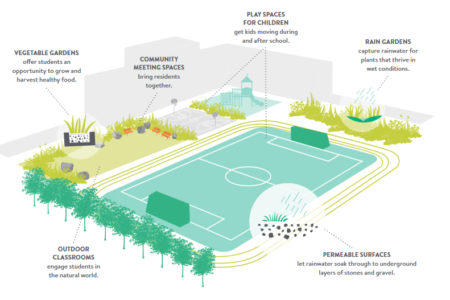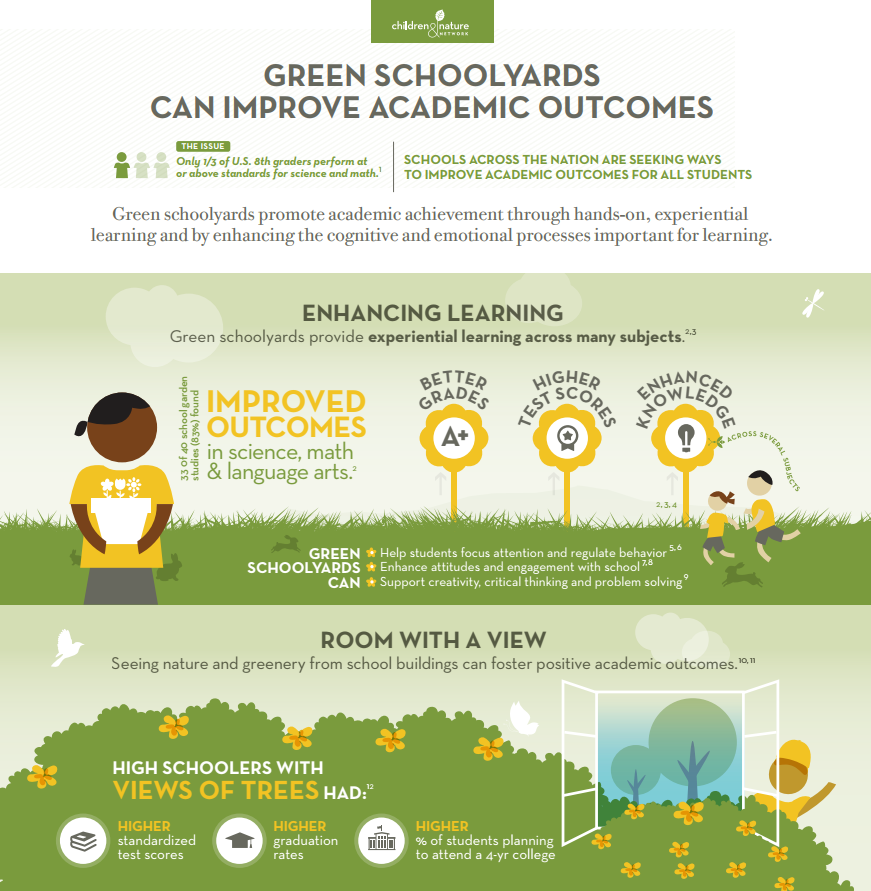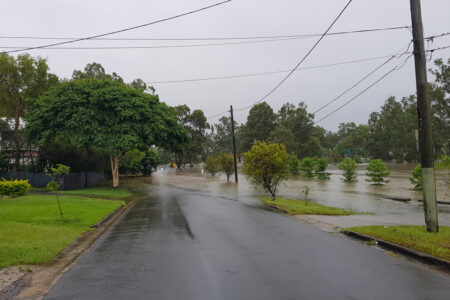
Share On Social!
Finding safe places for kids to play hasn’t been easy for Latino families in Chicago.
 For example, 30 years ago, the federal government sued the Chicago Parks District for favoring parks in white neighborhoods and neglecting parks in African-American and Latino ones.
For example, 30 years ago, the federal government sued the Chicago Parks District for favoring parks in white neighborhoods and neglecting parks in African-American and Latino ones.
Schools in Chicago didn’t have equitable funding to maintain their own playgrounds over the years, either.
At the same time, the nation was shifting to a school day with less time for recess—creating a “recess drought.”
But school officials wanted to play a role in increasing access to safe green space for Latino kids and families.
Solving the ‘Recess Drought’ (and Preventing Floods)
Chicago Public Schools, the third largest school district in the nation, took a big first step in 2011.
They passed a recess policy with funding to repair and improve school playgrounds that were impacted by the “recess drought.”
Around that time, the city’s two water utilities in Chicago were looking for ways to control flooding and stormwater across the city.
Chicago Public Schools had more than 760 acres of impermeable surfaces (like concrete and asphalt) that do not absorb rainwater, and thus contribute to flooding issues.
Could these acres be used to engage kids in play…and help manage flooding?
The school district and the water management agencies discussed solutions to improve schoolyards not only for the students, but also for the entire community, with coordination from the Healthy Schools Campaign and Openlands, a Chicago land conservation group.
The found an answer: Green schoolyards.
What are Green Schoolyards?

The Chicago school and utility leaders created the Space to Grow program to transform Chicago schoolyards into green schoolyards.
Green schoolyards are beautiful, functional spaces to play, learn, garden and be outside. They also use special design elements to help reduce neighborhood flooding.
Green schoolyards add more than just grass. They include:
- diverse terrain;
- natural features such as flowers, trees, edible plants, logs, sticks, boulders, rocks, sand and water;
- gardens that support wildlife and food growing;
- natural play structures with loose parts and climbing structures; paths and trails;
- gathering places and outdoor classrooms;
- solar and other energy sources;
- rain water catchment;
- and mechanisms to capture stormwater runoff.
Many of these design elements can help reduce neighborhood flooding.
In Chicago, the Space to Grow program annually calls for six schools to get $1.5 million each to convert their concrete/asphalt surfaces into green schoolyards, and engage the entire school community in the planning process. The program runs from 2014-2019.
Funding will come from CPS; Chicago Department of Water Management and the Metropolitan Water Reclamation District of Greater Chicago; and Space to Grow, which is funded in part by the W.K. Kellogg Foundation.
Green Schoolyards Can Work Everywhere

Source: Children & Nature Network
Green schoolyards boost student’s academic performance, physical activity, mental health, and different types of play.
Through hands-on learning across many subjects, green schoolyards can help students focus; support critical thinking and problem solving; improve students attitudes about school; reduce aggression and discipline problems; and encourage imaginative, cooperative free play.
Additionally, green schoolyards provide three community benefits:
- Public space for kids and families to play after school, on weekends, and over the summer
- Outdoor classrooms during school hours
- Ecosystem services to address excess stormwater, heat islands, and poor air quality
School districts are some of the biggest landowners.
Whether school land is open to the public after school hours and whether schoolyards contribute to or reduce flooding could have a huge impact on the health, well-being, and resiliency of the surrounding community.
How Can You Push for Green Schoolyards?
Start the conversation in your school or community by calling or emailing to ask if your local water utility would be interested in pursuing green schoolyards.
Learn more about green schoolyards here.
Join the Children & Nature Network as they build a national movement to green schoolyards in every community.
By The Numbers
33
percent
of Latinos live within walking distance (<1 mile) of a park



